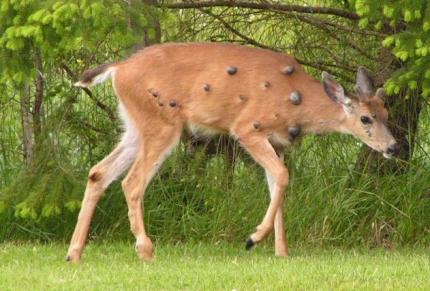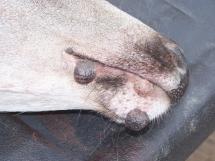
Deer and other wildlife occasionally have lumps or abscesses for a variety of reasons and most are insignificant to the health of the animal and to humans. Two common causes of lumps, growths, and abscesses include a condition called Caseous Lymphdenitis (CL) and Papillomas (warts). Information on these is below.
Monitoring and prevention
The Washington Department of Fish and Wildlife routinely monitors wildlife for disease, including sample testing from potentially sick animals reported by hunters.
While concern about CL or papillomas passing to humans through contact with an affected animal is small, as with all potential wildlife diseases, hunters should use standard game meat handling hygiene. Use protective gloves, avoid cutting into lumps and abscesses but cut away and discard them, clean equipment, and thoroughly cook meat. See more information at our Wild Game Meat Food Safety webpage.
Caseous Lymphadenitis (CL)
Caseous Lymphadenitis (CL)
Caseous lymphadenitis (CL) -- a condition that can produce lumpy swellings and abscesses in the lymph node area of the head, neck, and groin -- has occasionally been detected in white-tailed and mule deer in Washington and many other parts of western North America for many decades.
The CL condition, which develops with infections from the bacterium Corynebacterium pseudotuberculosis, is also found in domestic cattle, horses, goats and sheep. It can spread from animal to animal through contact with ruptured abscesses, contaminated soil or feed, and flies.
Potential transmission to humans
Although rare, CL can potentially be transmitted from animals to humans. Most such cases have occurred in sheep shearers with broken skin or abrasions after handling infected animals. Those cases have been successfully treated with antibiotics.
There are no reports of transmission from harvested deer to hunters, and properly handled and thoroughly cooked game meat is safe to eat.
CL in wildlife and livestock
The U.S. Department of Agriculture does not mandate reports of CL in domestic livestock, but a 2009 National Animal Health Monitoring Study found about one-third of goat producers with herds larger than 100 animals reported CL symptoms.
Incident reports indicate CL is uncommon in wildlife, but it is likely under-reported.
Cases in Washington
Although individual CL cases in deer have occasionally been found throughout Washington, Idaho, Montana, and British Columbia, several cases have recently occurred in southeast Washington.
In 2008, a hunter-harvested white-tailed buck deer in the Mill Creek drainage east of Walla Walla was reported with abscesses typical of CL and testing of tissue samples revealed they were caused by C. pseudotuberculosis. In 2016, a hunter-harvested white-tailed buck deer from the Jasper Mountain area, northeast of Walla Walla, was reported with swollen lymph nodes. Local wildlife biologists collected tissue samples that also tested positive for C. pseudotuberculosis.
Another hunter-harvested white-tailed buck deer from the Mud Creek area northeast of Dixie was photographed with lumpy swellings characteristic of CL, but no samples were collected for diagnostic testing. There were also reported sightings in 2016 of deer with lumps from the Jasper Mountain area south to the Mill Creek area.
The CL condition appears to have been present among southeast Washington deer for at least a decade and likely poses little risk to the overall population.
Papillomas (warts)

Papillomas (also known as fibromas, papillomas, fibropapillomas, or warts), are growths on the skin.
They are firm, hairless, gray or black in color, can be smooth or rough in texture, as small as peas or as large as footballs, and may grow in clusters. They may be found anywhere on the outside of an animal’s body. These growths are caused by viruses that are contagious within the same species. Papilloma viruses that infect one species usually do not infect another species. Typically, papillomas will eventually outgrow their blood supply and fall off.
Species Affected
All species of mammals have their own type of papilloma virus, but in Washington papillomas are most frequently observed on deer, elk, and moose. These growths do not usually cause the animal harm unless they are in a location that impedes the animal’s ability to see, eat, or walk.
How are papillomas spread?
Papilloma viruses may be transferred from animal to animal by biting insects, direct contact, or sharing rubbing posts and bedding sites. Papillomas are most frequently seen during the late summer and into the fall, probably due to increased biting insect activity during this time of year.
Potential transmission to humans, pets, or livestock
The viruses that cause papillomas in wildlife are not contagious to humans. Pets and livestock are not susceptible to the viruses that cause papillomas in wildlife. However, they can become infected with papilloma viruses that affect their own species.
Can I eat meat from an animal with papillomas?
Papillomas are limited to the skin and can easily be trimmed away. The meat from animals with papillomas is suitable for consumption.